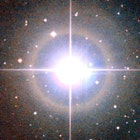BASIC program for visual binary stars
BINARY STARS with short orbital periods can change markedly in appearance from year to year, making descriptions in books out of date. This BASIC program was written by E. R. ‘Ted’ Wood (1914–98), based on equations given by Jean Meeus in his book Astronomical Formulae for Calculators. It can be used to find the separation and position angle of any binary pair whose orbital elements are known, for any required date.
A free BASIC application for Mac, PC, and Linux can be found here.
The program takes as its input the seven orbital elements that describe the orbit of a binary star, as follows:
P .... the orbital period in years
T .... the date of periastron (year and decimals)
a .... the semimajor axis of the orbit, in seconds of arc
e .... the eccentricity of the orbit
i .... the inclination of the orbit to the plane of the sky, in degrees
ω (lower case omega) .... argument of periastron, in degrees
Ω (upper case omega) .... position angle of the ascending node, in degrees
Orbital elements for visual binaries can be found in the Sixth Catalog of Orbits of Visual Binary Stars by Rachel A. Matson, Stephen J. Williams, William I. Hartkopf, and Brian D. Mason. The catalogue is updated regularly.
For a selection of visual binaries suitable for observation with modest telescopes see the table on this page.
PROGRAM
1 REM Binary star orbit program
2 REM By Ted Wood
10 DEF FN C(W) = 0.01745329252*W
20 PX=3.141592654: C=6.283185307
30 INPUT "Period, P (years) ";P
40 INPUT "Date of periastron, T ";T
50 INPUT "Semi-major axis, a ";A1
60 INPUT "Eccentricity, e ";S
70 INPUT "Inclination, i ";I
80 INPUT "Arg. of periastron, w ";W
90 INPUT "P.A. of ascending node ";L
100 I=FN C(I): L=FN C(L): W=FN C(W)
110 N=C/P
120 INPUT "Date of obs. (year) ";D
130 MA=N*(D-T)
140 GOSUB 300
150 R=A1-A1*S*COS(EA)
160 Y=SIN(NU+W)*COS(I)
170 X=COS(NU+W)
180 Q=ATN(Y/X)
190 IF X<0 THEN Q=Q+PX: GOTO 210
200 IF Q<0 THEN Q=Q+C
210 TH=Q+L: IF TH>C THEN TH=TH-C
220 RH=R*X/COS(Q)
230 PRINT "P.A. = ";INT(TH/FN C(1)*10+0.5)/10;" deg."
240 PRINT "Sep. = ";INT(RH*100+0.5)/100;" arcsec"
250 INPUT "New date (Y/N) ";AN$
260 IF AN$="Y" OR AN$="y" THEN GOTO 120
265 IF AN$="N" OR AN$="n" THEN GOTO 275
270 GOTO 250
275 INPUT "New binary (Y/N) ";AN$
280 IF AN$="Y" OR AN$="y" THEN GOTO 10
290 IF AN$="N" OR AN$="n" THEN END
295 GOTO 275
300 M=MA-C*INT(MA/C): EA=M
310 A=EA-(S*SIN(EA))-M
320 IF ABS(A)<0.000001 THEN GOTO 350
330 A=A/(1-(S*COS(EA)))
340 EA=EA-A: GOTO 310
350 TU=SQR((1+S)/(1-S))*TAN(EA/2)
360 NU=2*ATN(TU)
370 RETURN
EXAMPLE
This example shows how the Binary Star Orbit program works. The data are for the star Xi Ursae Majoris. Your computer should duplicate the results given here exactly.
Period, P (years) 59.88
Date of periastron, T 1995.07
Semi-major axis, a 2.536
Eccentricity, e 0.398
Inclination, i 122.13
Arg. of periastron, w 127.94
P.A. of ascending node 101.85
Date of obs. (year) 2010
P.A. = 211.2 deg.
Sep. = 1.61 arcsec
New date (Y/N) Y
Date of obs. (year) 2015.5
P.A. = 174 deg.
Sep. = 1.81 arcsec
